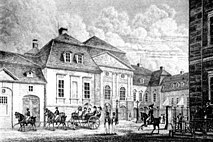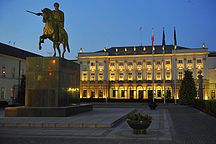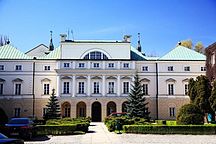| Revision as of 20:32, 19 April 2009 edit70.133.67.37 (talk) english:horns← Previous edit | Revision as of 20:56, 19 April 2009 edit undoJacurek (talk | contribs)9,609 editsm Reverted edits by 70.133.67.37 (talk) to last version by LokyzNext edit → | ||
| Line 1: | Line 1: | ||
| {{foreignchars|]|Radziwill}} | {{foreignchars|]|Radziwill}} | ||
| ]. As Princes of the Holy Roman Empire, the ''' |
]. As Princes of the Holy Roman Empire, the '''Radziwiłł Coat of Arms''' uses The Trąby in the center of a Black Eagle in a Golden Shield.]]<!-- Unsourced image removed: ] --> | ||
| '''Radziwiłł''' ({{lang-lt|Radvila}}; {{lang-de|Radziwill}}; {{lang-be|Радзівіл, Radzivił}}; {{lang-la|Radvil}}) is a family of ] which has been powerful and important for centuries, first in the ] and later in the ]. The Radziwiłł family received the title of '']'' (Prince, {{lang-pl|książę}}, {{lang-be|князь, kniaź}} {{lang-lt|kunigaikštis}}), from the ]. | |||
| Line 14: | Line 14: | ||
| In Polish, the name has been spelled ''Radziwiłł'' now for several centuries, but it originally comes from the Lithuanian name, spelled in {{lang-lt|Radvila}}, plural ''Radvilos''. The name is spelled in {{lang-be|Радзівіл, Radzivił}} (plural ''Радзівілы'', ''Radziviły''). | In Polish, the name has been spelled ''Radziwiłł'' now for several centuries, but it originally comes from the Lithuanian name, spelled in {{lang-lt|Radvila}}, plural ''Radvilos''. The name is spelled in {{lang-be|Радзівіл, Radzivił}} (plural ''Радзівілы'', ''Radziviły''). | ||
| The |
The Radziwiłł family kept its importance and ] status for over five centuries. For centuries leading representatives of the family were proctectors of ]n sovereignty from a political aggression of Poland and a military aggression of Russia. They acquired and maintained great wealth and influence from 15th century-16th century until the beginning of ] in 1939. The family has produced many outstanding politicians, military commanders, clergymen, cultural benefactors and entrepreneurs who left a significant mark on ], ], ] and general European history and culture. | ||
| A branch of Radvila Astikas' descendants became powerful ]s and their name is remembered as one of the most famous magnate families in |
A branch of Radvila Astikas' descendants became powerful ]s and their name is remembered as one of the most famous magnate families in Grand Duchy of Lithuania (later, the Polish-Lithuanian Commonwealth). The Radziwiłł family reached the heights of its importance and power during the ] of the Polish-Lithuanian Commonwealth in the 16th century. Lithuanian Radziwiłłs were elevated to the title of ''Reichsfürst'' (Prince of the Empire), granted by ] after the ] at ] in 1515. This title was very unusual among ] (Polish-]). | ||
| The oldest still-standing monuments of the Radivilias family is a gothic parish church in ](cir. 1406) and gothic St. George church (cir. 1445) in the very centre of Lithuania, Kėdainiai town. The main seat of ]-] Radziwiłł family line was ] and since the second half of the 17th century - ] (both in ]). This line became extinct after the death of ] in 1695. Since the 18th century all Radziwiłłs are descendants of the Nieśwież-Ołyka Radziwiłł family line, which had its main residence at ] (Nieśwież) in present-day ]. Other residences and properties included ], ], ], ], ], ], ], ] and ]. | The oldest still-standing monuments of the Radivilias family is a gothic parish church in ](cir. 1406) and gothic St. George church (cir. 1445) in the very centre of Lithuania, Kėdainiai town. The main seat of ]-] Radziwiłł family line was ] and since the second half of the 17th century - ] (both in ]). This line became extinct after the death of ] in 1695. Since the 18th century all Radziwiłłs are descendants of the Nieśwież-Ołyka Radziwiłł family line, which had its main residence at ] (Nieśwież) in present-day ]. Other residences and properties included ], ], ], ], ], ], ], ] and ]. | ||
Revision as of 20:56, 19 April 2009

Radziwiłł (Template:Lang-lt; Template:Lang-de; Template:Lang-be; Template:Lang-la) is a family of high nobility which has been powerful and important for centuries, first in the Grand Duchy of Lithuania and later in the Polish-Lithuanian Commonwealth. The Radziwiłł family received the title of Reichsfürst (Prince, Template:Lang-pl, Template:Lang-be Template:Lang-lt), from the Holy Roman Empire.
Coat of arms and motto
Family motto: The Lord is Our Counsel (Polish: Bóg nam radzi, Belarusian: Бог нам раіць, Boh nam rajić),
History


The Radziwill family descended from Lithuanian bajorai-ducal courtiers, lesser nobility, who advanced considerably in the 15th century. They are descendants from old Lithuanian Astikai family, that had possessions near Kernavė. Radziwiłł family's known ancestor has been a Lithuanian noble Radvila Astikas. His father Kristinas Astikas was the first to receive Trąby Coat of Arms after the Union of Horodło in 1413, which became the coat of arms of the family. The first person to use Radvila as a family name was a son of Radvila Astikas, Mikalojus Radvila whose sons became the progenitors of the three known Radziwiłł family lines.
In Polish, the name has been spelled Radziwiłł now for several centuries, but it originally comes from the Lithuanian name, spelled in Template:Lang-lt, plural Radvilos. The name is spelled in Template:Lang-be (plural Радзівілы, Radziviły).
The Radziwiłł family kept its importance and noble status for over five centuries. For centuries leading representatives of the family were proctectors of Lithuanian sovereignty from a political aggression of Poland and a military aggression of Russia. They acquired and maintained great wealth and influence from 15th century-16th century until the beginning of Second World War in 1939. The family has produced many outstanding politicians, military commanders, clergymen, cultural benefactors and entrepreneurs who left a significant mark on Lithuanian, Belarusian, Polish and general European history and culture.
A branch of Radvila Astikas' descendants became powerful magnates and their name is remembered as one of the most famous magnate families in Grand Duchy of Lithuania (later, the Polish-Lithuanian Commonwealth). The Radziwiłł family reached the heights of its importance and power during the Golden Age of the Polish-Lithuanian Commonwealth in the 16th century. Lithuanian Radziwiłłs were elevated to the title of Reichsfürst (Prince of the Empire), granted by Maximilian I, Holy Roman Emperor after the Jagiellonian-Habsburg congress at Vienna in 1515. This title was very unusual among szlachta (Polish-Lithuanian nobility).
The oldest still-standing monuments of the Radivilias family is a gothic parish church in Vyžuonos(cir. 1406) and gothic St. George church (cir. 1445) in the very centre of Lithuania, Kėdainiai town. The main seat of Biržai-Dubingiai Radziwiłł family line was Dubingiai Castle and since the second half of the 17th century - Biržai Castle (both in Lithuania). This line became extinct after the death of Ludwika Karolina Radziwiłł in 1695. Since the 18th century all Radziwiłłs are descendants of the Nieśwież-Ołyka Radziwiłł family line, which had its main residence at Niasvizh Castle (Nieśwież) in present-day Belarus. Other residences and properties included Mir Castle, Ołyka, Biržai, Kėdainiai, Szydłowiec, Taujėnai, Lubča, Połoneczka and Radziwiłłów.
Due to the activities of Janusz Radziwilłł during The Deluge, the family lost much of its wealth and power.
- Residential castles of the Radziwill family
-
 Biržai Castle
Biržai Castle
-
Olyka Castle
-
 Mir Castle
Mir Castle
-
 Lubcza Castle
Lubcza Castle
-
 Nesvizh Castle
Nesvizh Castle
Members



The Radziwiłł family members include:
- Mikalojus Radvila, c. 1450-1509, voivode, chancellor
- Mikolaj Radziwiłł, 1470-1521, chancellor
- Jerzy Radziwiłł, 1480-1541, hetman, voivode, castellan, marshal
- Mikołaj III Radziwiłł, c. 1492-1530, Bishop of Samogitia
- Mikołaj "the Red" Radziwiłł, 1512-1584, hetman, chancellor
- Mikołaj "the Black" Radziwiłł, 1515-1565, marshal, chancellor, palatine
Since 1515 both Mikolajs and the Radziwill family were elevated to Reichsfürsten of the Holy Roman Empire
- Barbara Radziwiłł, 1520-1550, Queen of Poland
- Mikołaj VII Radziwiłł, 1546-1589, chamberlain
- Krzysztof Mikołaj "the Lightning" Radziwiłł, 1547-1603, hetman
- Mikołaj Krzysztof "the Orphan" Radziwiłł 1549-1616, voivode, marshall, castellan, prince
- Grzegorz Radziwiłł 1558-1600, Cardinal of Kraków 1591-1600
- Krystyna Radziwiłł, 1560-1580
- Grzegorz Radziwiłł, 1578-1613, castellan
- Janusz Radziwiłł, 1579-1620, castellan
- Krzysztof II Radziwiłł, 1585-1640, hetman
- Albert III Radziwiłł, 1589-1636, castellan
- Albrycht Stanisław Radziwiłł, 1595-1656, chancellor
- Janusz Radziwiłł, 1612-1655, hetman, voivode
- Bogusław Radziwiłł 1620-1669
- Michał Kazimierz Radziwiłł, 1625-1680, hetman, chancellor
- Ludwika Karolina Radziwiłł, 1667-1695
- Karol Stanisław Radziwiłł, 1669-1719, Grand Chancellor of Lithuania
- Katarzyna Barbara Radziwiłł, 1693-1730
- Michał Kazimierz "Rybeńko" Radziwiłł, 1702-1762
- Karol Stanisław "Panie Kochanku" Radziwiłł, 1734-1790, voivode of Vilnius and Marshal of the Bar Confederation
- Antoni Henryk Radziwiłł, 1775-1833, statholder
- Michał Gedeon Radziwiłł, 1778-1850, senator, general
- Elisabeth Radziwill, cousin and desired bride of Wilhelm I, German Emperor
- Catherine Radziwill, 1858-1941, Polish princess, stalked and ruined the career of Cecil Rhodes
- Janusz Radziwiłł 1880-1967, senator
- Stanisław Albrecht Radziwiłł 1914-1976, married Caroline Lee Bouvier, younger sister of First Lady Jacqueline Kennedy.
- Anna Radziwiłł, 1939-2009, Polish senator, minister, secretary of state
- George Andrew Dominique Jerome Peter Leon Radziwill (1942 - 2001)
- Konstanty Radziwiłł b. 1958 r., Polish doctor
- Anthony Radziwill 1959-1999, American filmmaker
- Anna Christina Radziwill b. 1960, Daughter of Stanislas Radziwill and Caroline Lee Bouvier (Lee Radziwill), sister of Anthony
- Carole Radziwill b. 1968, widow of Anthony Radziwill, author
- Roza XVI Radziwill, now Roza Broel-Plater b. December 25, 1934. Polish Princess.
- Krzysztof Konstanty Radziwill
 |
 |
 | ||
| Radziwill Palace in Berlin | Grand Radziwill Palace in Warsaw | Lesser Radziwill Palace in Warsaw |
See also
External links
- Radziwill Family Links and Genealogy
- Short history of the Radziwill Family
- The Radziwill Dynasty: From Pagan Times to the 1960s
- Template:Pl icon Radziwiłłowie pędzlem i piórkiem Józefa Mehoffera - History and gallery from exhibition at Słupsk Museum
- Template:Lt icon Radziwill family website